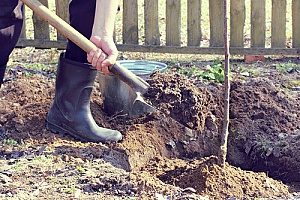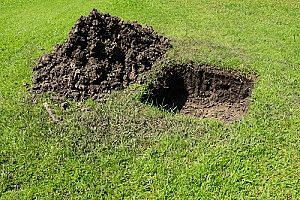 Fill dirt is the material used to fill low areas, change the surface grade to improve drainage, or build up ground elevation for landscaping projects or on construction sites. Fill dirt, also called simply “fill”, consists of partially broken down soil that contains clay, sand, silt, and stones, and any other materials found in the source ground. Unlike topsoil, fill dirt is heavy and inorganic, and in some cases can be stony. Quality fill is mostly inorganic. It is these inorganic characteristics that make it ideal as fill because it does not decompose and settle like organic soils are prone to do.
Fill dirt is the material used to fill low areas, change the surface grade to improve drainage, or build up ground elevation for landscaping projects or on construction sites. Fill dirt, also called simply “fill”, consists of partially broken down soil that contains clay, sand, silt, and stones, and any other materials found in the source ground. Unlike topsoil, fill dirt is heavy and inorganic, and in some cases can be stony. Quality fill is mostly inorganic. It is these inorganic characteristics that make it ideal as fill because it does not decompose and settle like organic soils are prone to do.
Fill dirt is necessary for site preparation and as base for a home or building, an addition, road, or sidewalk. These structures need a solid, stable base of support. Fill dirt is not suitable for supporting a garden or vegetation.
Save Money and Time by Ordering the Right Amount of Fill Dirt the First Time
When you need to estimate the cost of your building project, you first need to calculate the amount of fill dirt your project needs and its cost. This calculation will only be an estimate because the dirt will settle after it is compacted. Settlement will mean you will need a little more fill for building up, filling in or leveling out the desired space. You should talk to your fill dirt supplier about how to factor this into your estimate so that you purchase the right amount of fill.
A fairly accurate estimate is important for a number of reasons. Quality fill dirt is available at very competitive rates, but if you order too much, you are wasting your money. On the other hand, if you do not order enough, you will incur unnecessary delivery costs. Also, you incur the cost associated with having work delays if work stops until more dirt is delivered.
Below are the steps to take to estimate the amount of fill you will need.
1. Measure the length and width, in feet, of the area where you want to use fill. Measuring the size of the area you will use fill can be tricky. To help ensure your accuracy, you should have someone help you take the measurements. A helper will give you an extra pair of hands as well as an extra pair of eyes.
 When you are working on an area that is circular or irregularly shaped, measuring the area can be more challenging. For a circle, you will need to measure the diameter. For a series of circular shapes, measure the diameter of each one. Your dirt contractor can help you with those measurements.
When you are working on an area that is circular or irregularly shaped, measuring the area can be more challenging. For a circle, you will need to measure the diameter. For a series of circular shapes, measure the diameter of each one. Your dirt contractor can help you with those measurements.
2. Determine the area, or total square footage, of the space by multiplying the length times the width. Once you have the length and width measurements, determining the square footage is simple. Simply multiply the length times the width. For example, you are building a sidewalk that is 25 feet long and 4 feet wide, the total square footage is 100 square feet (25′ x 4′). If you are building a garden shed that is 10 feet long and 8 feet wide, the total square footage is 80 square feet (10′ x 8′). If you are connecting the two structures, add the total square footage together for 180 square feet (100′ + 80′).
3. Convert your square footage into cubic yards. Fill dirt is sold in cubic yards. To convert your square footage into cubic yards, first divide your square footage by 1,000, and then multiply your result by 3. Your result tells you how many cubic yards will fill one inch of depth.
Applying that formula to the example above using 180 square feet, you would need .54 cubic yards:
180 / 1,000 = .18 ; .18 x 3 = .54 cubic yards
You would use the same formula for a larger project. For example, if you need fill to provide a base for a garage structure that is 40′ x 25′ (totaling 1,000 square feet), along with a paved driveway that is 25′ x 8′ (totaling 200 square feet), you would have a total area of 1,200 square feet for fill.
To convert that square footage into cubic yards:
1,200/1,000=1.2; 1.2 x 3 = 3.6 cubic yards.
To give you a sense of volume, there are 27 cubic feet in one cubic yard (3′ x 3′ x 3′). A full-size pickup truck holds about 2 cubic yards.
 4. Multiply your cubic yardage by the inches of depth you need to fill. The calculations so far are based on one inch of fill depth. In most cases, however, once inch of fill is not enough. Determine how many inches of depth you need. Then multiply the cubic yardage by the inches of depth.
4. Multiply your cubic yardage by the inches of depth you need to fill. The calculations so far are based on one inch of fill depth. In most cases, however, once inch of fill is not enough. Determine how many inches of depth you need. Then multiply the cubic yardage by the inches of depth.
For our garden shed and path, assume you need a two -inch depth. You would multiply .54 cubic yards x 2 inches = 1.08 cubic yards of fill.
For the garage and driveway, you may need four inches of fill depth. In that case, you would multiply 3.6 cubic yards x 4 inches = 14.4 cubic yards of fill.
5. Give yourself a margin of error. When you fill area is circular or irregularly shaped, you should add extra cubic yards of fill dirt. You should add an additional 10-15% of your total cubic yardage. Better yet, consult with your dirt contractor to determine the margin of error.
Contact Dirt Connections for More Information
Whether you are a contractor or a DIYer, it pays to consult with the experts at Dirt Connections, the best Virginia fill dirt contractor, before you place your fill dirt order. They can discuss your project with you and help you determine what types of fill you need and how much. If necessary, they will visit your site to help you make the necessary calculations, estimate the cost, and schedule a delivery directly to your site. Contact Dirt Connections for more information.









































